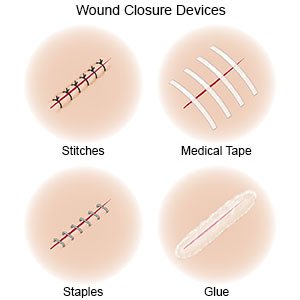Head Laceration
Medically reviewed by Drugs.com. Last updated on Apr 6, 2025.
What do I need to know about a head laceration?
A laceration happens when the skin and soft tissues under it are torn. Head lacerations usually bleed more than other types of lacerations.
What should I do if I get a head laceration?
- Apply pressure to the wound with a clean cloth. Pressure will help bleeding to slow or stop.
- Have someone take you to the nearest healthcare provider.
How is a head laceration treated?
Treatment depends on how large and deep your laceration is. You may need to see a specialist if the laceration is deep or on your face. You may need any of the following:
- Wound cleaning may help remove dirt or debris and decrease the risk for infection. Your healthcare provider may need to look inside your wound for foreign objects, such as glass or gravel. Your provider may give you medicine to numb the area and decrease pain. You may also be given medicine to help you relax.
- Wound closure with stitches, staples, tissue glue, or medical strips may be needed. Your provider may give you medicine to numb the area and decrease pain. You may also be given medicine to help you relax. Some lacerations may heal better without stitches. Your wound may instead be left open for some days if there is a risk for infection. It may also be left open if it has been more than 24 hours since your injury happened. You may need to have your laceration cleaned for several days before it is closed.

- Medicine to treat pain or prevent infection may be given. Your provider will decide if you need a tetanus shot. Wounds at high risk for tetanus infection include wounds with dirt or saliva in them. You should get a tetanus shot within 72 hours of getting a laceration or wound. Tell your provider if you have had the tetanus vaccine or a booster within the last 5 years.
- Surgery may be needed if your laceration needs additional cleaning or removal of foreign objects.
How do I care for my head laceration?
- Rest as needed. Some activities may cause too much pressure in your head. Your laceration may begin to bleed.
- Do not get your wound wet. Carefully wash your wound with soap and water as directed. Gently pat the area dry or allow it to air dry.
- Change your bandages. Apply new, clean bandages as directed. Do not put powders or lotions over your wound.
- Apply ice to decrease swelling and pain. Apply ice to the wound for 15 to 20 minutes every hour or as directed. Use an ice pack, or put crushed ice in a plastic bag. Cover the bag with a towel before you apply it.
- Apply antibiotic ointment as directed. Your healthcare provider may give you antibiotic ointment to put over your wound if you have stitches. If you have strips of tape over your wound, let them dry up and fall off on their own. You may gently remove strips of tape if they do not fall off within 14 days. If you have glue over your wound, do not remove or pick at it. If the glue comes off, do not replace it with glue that you have at home.
- Check the area every day for signs of infection. Signs may include redness, pus, and warmth around the wound.
- Do not smoke. Nicotine and other chemicals in cigarettes and cigars can prevent your wound from healing. Ask your provider for information if you currently smoke and need help to quit. E-cigarettes or smokeless tobacco still contain nicotine. Talk to your provider before you use these products.
Have someone call your local emergency number (911 in the US) if:
- You cannot be woken.
- Your mood or behavior changes.
- You have a seizure.
When should I seek immediate care?
- You have bleeding that does not stop after 10 minutes of holding firm, direct pressure over the wound.
- Your wound reopens.
- You have tingling, weakness, or numbness near your wound.
When should I call my doctor?
- You have a fever or chills.
- Your wound is red, warm, swollen, or has pus coming from it.
- You have pain that gets worse, even after taking pain medicine.
- You have questions or concerns about your condition or care.
Care Agreement
You have the right to help plan your care. Learn about your health condition and how it may be treated. Discuss treatment options with your healthcare providers to decide what care you want to receive. You always have the right to refuse treatment. The above information is an educational aid only. It is not intended as medical advice for individual conditions or treatments. Talk to your doctor, nurse or pharmacist before following any medical regimen to see if it is safe and effective for you.© Copyright Merative 2025 Information is for End User's use only and may not be sold, redistributed or otherwise used for commercial purposes.
Further information
Always consult your healthcare provider to ensure the information displayed on this page applies to your personal circumstances.
